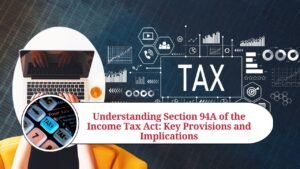Section 133B of the Income Tax Act outlines the powers and restrictions for income-tax authorities when they conduct an inspection at a taxpayer’s premises. It provides clear protections for taxpayers, particularly under Subsection (3), which restricts the removal of assets and documents from the site of inspection. In this blog, we’ll cover five essential facts about Section 133B(3) that every taxpayer should understand.
Key Facts:
- Inspection Without Removal of Assets
- Clearly Defined Authorized Officials
- Jurisdiction-Specific Authority
- Protecting Taxpayer Rights During Inspections
- Common Questions About Section 133B(3)

What is Section 133B(3) of the Income Tax Act?
Section 133B of the Income Tax Act enables income-tax authorities to enter any place of business or profession to collect information necessary for tax purposes. However, Subsection (3) of Section 133B explicitly restricts officials from removing any books of account, financial documents, cash, stock, or other valuable items from the premises. This ensures that taxpayer assets remain protected, even during an official inspection, providing a level of reassurance that belongings and sensitive information won’t be taken away.
1. Inspection Without Removal of Assets
A key provision under Section 133B(3) is the restriction on removing physical assets and financial records. Income-tax authorities are permitted to review and inspect the following items on-site but are not allowed to remove them from the taxpayer’s premises:
- Books of Account: Physical or digital records detailing business finances must stay on-site.
- Documents: Financial statements, tax returns, invoices, and other relevant documents cannot be seized.
- Cash, Stock, and Other Valuables: Any monetary assets, stock, or valuable articles must remain in the taxpayer’s possession.
This restriction protects taxpayers by ensuring that their records and assets stay within their control during the inspection.
2. Clearly Defined Authorized Officials
Only specific officials are empowered to conduct inspections under Section 133B. The authorized officials include:
- Joint Commissioner
- Assistant or Deputy Director
- Assessing Officer
Additionally, Inspectors of Income-tax can conduct inspections if they have been authorized by the Assessing Officer. This limitation is in place to ensure that inspections are conducted by trained and responsible officials, reducing the chances of procedural misconduct.
3. Jurisdiction-Specific Authority
Income-tax Inspectors, while authorized under specific conditions, are limited to conducting inspections within the defined jurisdiction of their Assessing Officer. This jurisdictional boundary ensures that inspections are performed only in areas where the Assessing Officer has authority, safeguarding taxpayers from overreach and ensuring lawful adherence to the inspection’s geographic limits.
4. Protecting Taxpayer Rights During Inspections
Section 133B(3) is designed to protect taxpayer rights by enforcing strict boundaries on the actions of income-tax authorities during inspections. Here’s how this benefits taxpayers:
- Preservation of Assets: Taxpayers retain control over their assets and documents throughout the inspection, minimizing potential disruption.
- Legal Boundaries for Officials: Only specific, designated officials with clear jurisdictional authority can conduct inspections, ensuring taxpayer protection against unauthorized inspection attempts.
This structured approach reassures taxpayers that inspections are conducted in a manner that respects both their rights and the legal process.
5. Common Questions About Section 133B(3) of the Income Tax Act
To clarify how Section 133B(3) impacts taxpayers, here are answers to some frequently asked questions:
Can income-tax officials take photographs or make digital copies of documents during an inspection?
Yes, while they cannot remove physical documents, officials may make digital records or take notes to help in their assessment. This allows them to gather necessary information without physically seizing assets or documents.
What happens if an unauthorized official conducts an inspection?
If an inspection is conducted by someone who is not authorized under Section 133B, it may be deemed invalid, and taxpayers can legally challenge the inspection process.
Can multiple officials inspect a single premises at the same time?
Yes, as long as they are authorized and are acting within the limits of their jurisdiction. This ensures that inspections are properly supervised and legally compliant.
Are there penalties for officials who remove assets in violation of Section 133B(3)?
Yes, any unauthorized removal of assets or documents is considered a breach of protocol, and officials can face disciplinary actions. Taxpayers can report such actions to relevant authorities.
Does Section 133B(3) apply to residential properties?
Section 133B typically applies to business or professional premises. Residential properties are subject to separate provisions and require additional permissions under other sections for inspection.
Conclusion: Ensuring Transparency and Accountability in Tax Inspections
Section 133B(3) of the Income Tax Act provides a balanced framework for tax inspections, allowing income-tax authorities to gather necessary information while protecting taxpayer rights. By clearly restricting the removal of assets and documents, it ensures transparency, accountability, and peace of mind for taxpayers undergoing inspections.
For more insights on tax compliance, inspection protocols, and taxpayer rights, visit our website www.smarttaxsaver.com. We regularly publish in-depth articles to help you navigate the complexities of the Income Tax Act.




